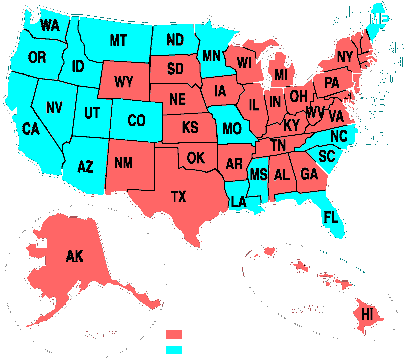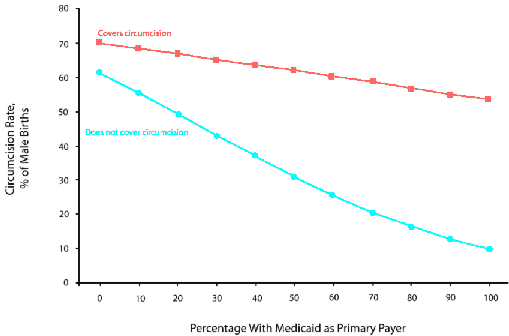When they say it's not the money... |
|
If you want to see what motivates a doctor to circumcise perfectly healthy baby boys ... just look in his driveway. |
- Anonymous
"I have some good friends who are obstetricians outside the military, and they look at a foreskin and almost see a $125 price tag on it. Each one is that much money. Heck, if you do 10 a week, that's over $1,000 a week, and they don't take that much time." |
- Dr.Thomas Wiswell
quoted in the Boston Globe
June 22, 1987
Infant circumcision in the US is largely covered by health insurance. It declined rapidly in the UK after the National Health Service was set up in 1947, and doctors delivering babies were no longer able to charge extra for doing it.
Medicaid funding of circumcision of the boys of poor parents is being withdrawn as states find the cost is an unnecessary burden:

States of the USA that do not fund circumcision under Medicaid.
As from: | State |
September 1, 1982 | California |
1986 | North Dakota |
c. 1994 | Oregon |
before 1999 | Nevada, Washington |
August 1, 2000 | Mississippi |
August 1, 2002 | Missouri |
October 1, 2002 | Arizona |
December 1, 2002 | North Carolina |
January 1, 2003 | Montana |
July 1, 2003 | Utah |
July 1, 2003 | Florida |
February 3, 2004 | Maine |
before April, 2005 | Louisiana |
July 1, 2005 | Idaho |
August 1, 2005 | Minnesota |
February 1, 2011 | South Carolina |
July 1, 2011 | Colorado |
A study by Leibowitz et al. showed that the circumcision rate falls where it is not covered by Medicaid:

Predicted neonatal male circumcision rates as a function of Medicaid coverage of circumcision and the percentage of male newborns in hospital for whom Medicaid is their primary payer: Nationwide Inpatient Sample, 2004. |
The International Coalition for Genital Integrity's |
The International Coalition for Genital Integrity's Medicaid Project surveyed all US states in 1999, and was able to account for 181,292 circumcisions costing a total of $20,255,217. According to HCIA-Sachs, Medicaid funded a total of 310,403 circumcisions, implying a total cost to the US taxpayer approaching $35,000,000.
Intactivists commonly claim that greedy doctors promote infant circumcision for purely financial reasons. There is clear evidence for this. The same survey found that where Medicaid paid more than $US60, circumcision was nearly twice as likely as where it paid less than $US50.

Fee | No of births | No of | % of |
< $50 | 99,267 | 20,103 | 20.2 |
$50-$60 | 143,336 | 39,597 | 27.6 |
>$60 | 304,425 | 115,805 | 38.0 |
So what is the real cost of circumcision? The AAP quotes an estimated total cost of $US150-270 million for the US annually. At 1.3 million circumcisions, that's only $125 - $225 each.That can only be a small fraction of the real cost.
Facility fees: The baby is usually already in a hospital, and the facility fees are not counted separately. In 1990-1, Mansfield et al. calculated that a baby and his mother spend an extra 0.26 of a day in hospital if he is circumcised. Generalizing the difference in hospital length of stay to the United States suggested an annual cost then of between $234 million and $527 million beyond charges for the procedure itself.
We can get another estimate of the cost from the fees for outpatient circumcision, in South Carolina $570, in Minnesota $288 - $800
Anaesthesia: Louisiana spent $121,695 on circumcision anaesthesia in 1999. (There were 10,763 circumcisions, but a significant proportion would have been committed without anaesthetic.) Other figures are unobtainable.
Supplies: Sterilized instruments, Circumstraints (TM), clamps and/or Plastibells (TM), antiseptics, syringes, gauze pads, etc.
Another estimate of the total immediate cost is as much as $2000-2500 for every male born (around 50.1% of all births in the US), based on the multiple added costs for each delivery which ends in a circumcision adding up to around an extra $2000-2500. The extra charges were around $1000 in 1991.
But the real costs of circumcision are to the baby, and the boy and man he becomes:
But the financial incentive to circumcision is not only from the payments for the operation. The foreskin itself is valuable, not only to its owner, as these pages stress, but to whoever possesses it.
- Neonatal Foreskin Epidermal Keratinocytes go for $250 at the Coriell Institute for Medical Research. (A footnote to the page says "THERE ARE NO EXPRESS OR IMPLIED WARRANTIES ... THAT THE USE OF THE MATERIAL WILL NOT INFRINGE ANY ... PROPRIETARY RIGHTS. Unless prohibited by law, Recipient assumes all liability for claims for damages against it by third parties which may arise from the use, storage or disposal of the Material except that, to the extent permitted by law." They probably haven't considered rights of ownership, or that "third parties" may include the neonate whose foreskin it is. It is highly probable that his parents were never told of the profitable use to which his foreskin has been put.)
Hurry! Buy now! Won't last at these prices!
|
PediatricsOctober 15, 2014 Circumcision of Privately Insured Males Aged 0 to 18 Years in the United States Geoffrey D. Hart-Cooper, Guoyu Tao, Jeffrey A. Stock and Karen W. Hoover Abstract BACKGROUND: Male circumcision confers protection against HIV, sexually transmitted infections, and urinary tract infections. Compared with circumcision of postneonates (>28 days), circumcision of neonates is associated with fewer complications and usually performed with local rather than general anesthesia. We assessed circumcision of commercially insured males during the neonatal or postneonatal period. METHODS: We analyzed 2010 MarketScan claims data from commercial health plans, using procedural codes to identify circumcisions performed on males aged 0 to 18 years, and diagnostic codes to assess clinical indications for the procedure. Among circumcisions performed in the first year of life, we estimated rates for neonates and postneonates. We estimated the percentage of circumcisions by age among males who had circumcisions in 2010, and the mean payment for neonatal and postneonatal procedures. RESULTS: We found that 156 247 circumcisions were performed, with 146 213 (93.6%) in neonates and 10 034 (6.4%) in postneonates. The neonatal circumcision rate was 65.7%, and 6.1% of uncircumcised neonates were circumcised by their first birthday. [So 34.3% of babies escaped cutting at birth, but this was subsequently whittled down (you should pardon the expression) to 32.2% This certainly underlines that maxim that if you can get him safely out of the hospital (and the paeditrician's surgery) he's fairly safe.] Among postneonatal circumcisions, 46.6% were performed in males younger than 1 year and 25.1% were for nonmedical indications. [i.e. unethical operations at parental whim. So 74.9% of post-neonatal circumcisions were "medical". The "medical" circumcision rate (assuming none of the neonatal circumcisions was "medical") was 4.56%. What we don't know is what proportion of those were for iatrogenic, forced-retraction related complaints.] The mean payment was $285 for a neonatal and $1885 for a postneonatal circumcision. CONCLUSIONS: The large number of nonmedical postneonatal circumcisions suggests that neonatal circumcision might be a missed opportunity for these boys. Delay of nonmedical circumcision results in greater risk for the child, and a more costly procedure. [What this misses out is that leaving the baby intact carries no risk and costs nothing.] Discussions with parents early in pregnancy might help them make an informed decision about circumcision of their child. [Translation: We can tell them they'd better do it now, because it'll cost more if they put it off.] |
Back to the Intactivism index page.
Christopher J. Mansfield, William J. Hueston, Mary Rudy, "Neonatal circumcision: associated factors and length of hospital stay", Journal of Family Practice, Volume 41, Number 4: Page 370-376, October 1995.